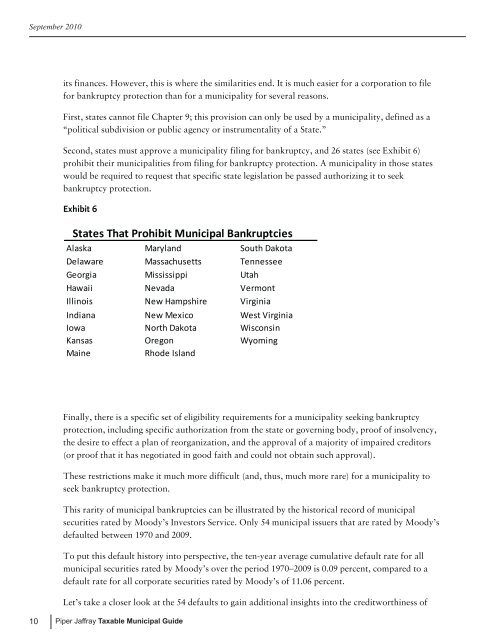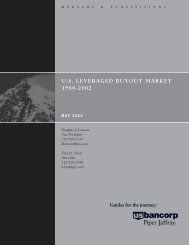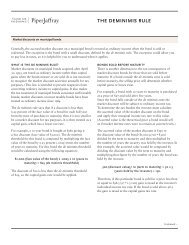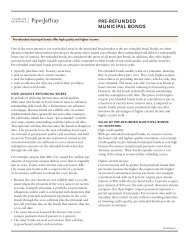Taxable Municipal Guide - Piper Jaffray
Taxable Municipal Guide - Piper Jaffray
Taxable Municipal Guide - Piper Jaffray
Create successful ePaper yourself
Turn your PDF publications into a flip-book with our unique Google optimized e-Paper software.
September 2010<br />
its finances. However, this is where the similarities end. It is much easier for a corporation to file<br />
for bankruptcy protection than for a municipality for several reasons.<br />
First, states cannot file Chapter 9; this provision can only be used by a municipality, defined as a<br />
“political subdivision or public agency or instrumentality of a State.”<br />
Second, states must approve a municipality filing for bankruptcy, and 26 states (see Exhibit 6)<br />
prohibit their municipalities from filing for bankruptcy protection. A municipality in those states<br />
would be required to request that specific state legislation be passed authorizing it to seek<br />
bankruptcy protection.<br />
Exhibit 6<br />
States That Prohibit <strong>Municipal</strong> Bankruptcies<br />
Alaska Maryland South Dakota<br />
Delaware Massachusetts Tennessee<br />
Georgia Mississippi Utah<br />
Hawaii Nevada Vermont<br />
Illinois New Hampshire Virginia<br />
Indiana New Mexico West Virginia<br />
Iowa North Dakota Wisconsin<br />
Kansas Oregon Wyoming<br />
Maine<br />
Rhode Island<br />
Finally, there is a specific set of eligibility requirements for a municipality seeking bankruptcy<br />
protection, including specific authorization from the state or governing body, proof of insolvency,<br />
the desire to effect a plan of reorganization, and the approval of a majority of impaired creditors<br />
(or proof that it has negotiated in good faith and could not obtain such approval).<br />
These restrictions make it much more difficult (and, thus, much more rare) for a municipality to<br />
seek bankruptcy protection.<br />
This rarity of municipal bankruptcies can be illustrated by the historical record of municipal<br />
securities rated by Moody’s Investors Service. Only 54 municipal issuers that are rated by Moody’s<br />
defaulted between 1970 and 2009.<br />
To put this default history into perspective, the ten-year average cumulative default rate for all<br />
municipal securities rated by Moody’s over the period 1970–2009 is 0.09 percent, compared to a<br />
default rate for all corporate securities rated by Moody’s of 11.06 percent.<br />
10<br />
Let’s take a closer look at the 54 defaults to gain additional insights into the creditworthiness of<br />
municipal issuers. Exhibit 7 shows the sectors of the 54 defaults by count.<br />
<strong>Piper</strong> <strong>Jaffray</strong> <strong>Taxable</strong> <strong>Municipal</strong> <strong>Guide</strong>
















